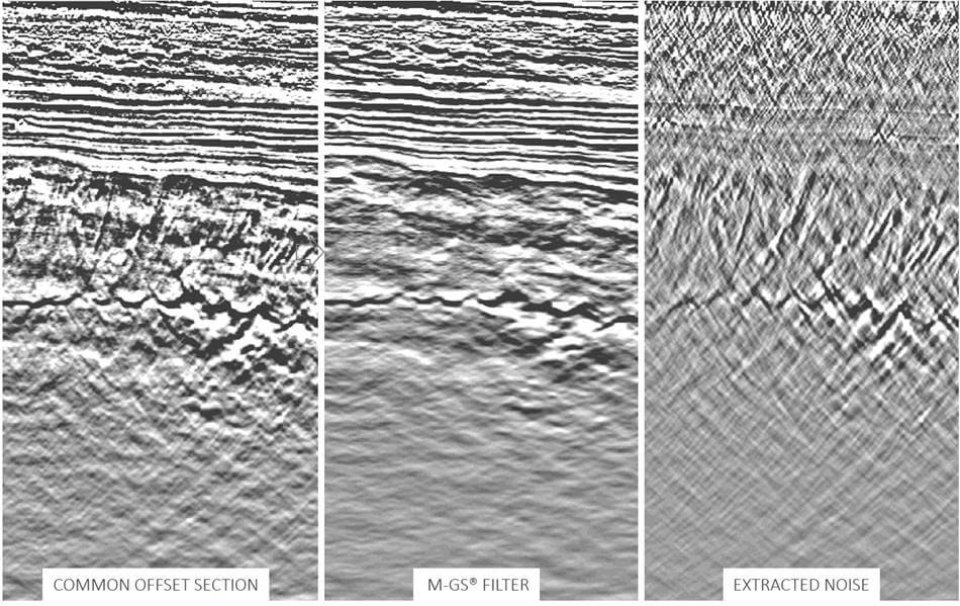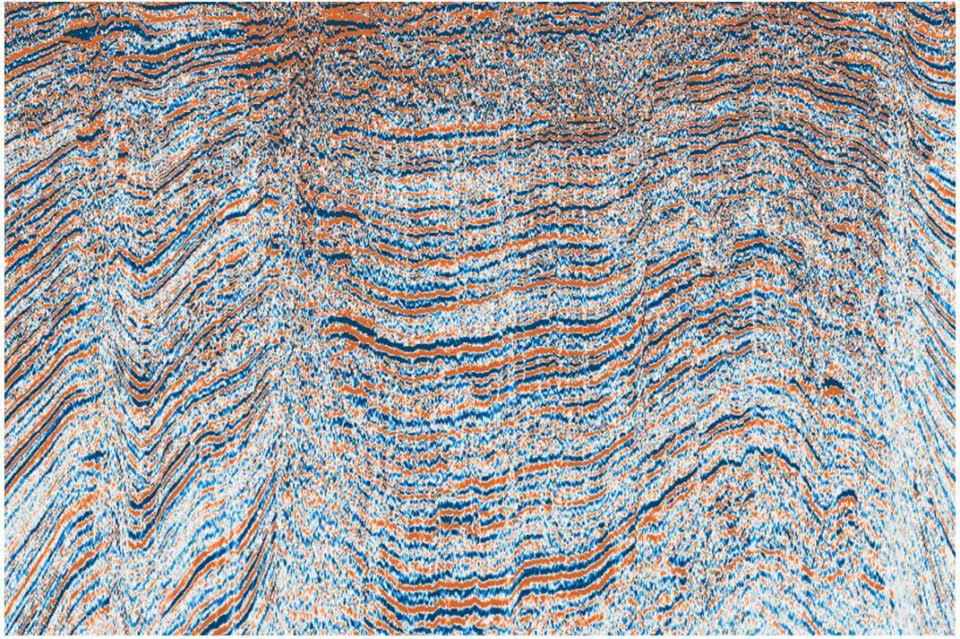Noise attenuation
PRE-STACK, POST-STACK, 4D Are you willing to give your seismic data a chance to be of optimal quality? Our adaptive geostatistical filters are proven to extract any type of noise from seismic data with an optimal preservation of signal. Even the most complex ones. M-GS® technology
PRESTACK
We are proud to have built the first of its kind operational offer of geostatistical filters for migrated pre-stack data for the Oil and Gas market. M-GS® filters are dedicated to the optimal extraction of any type of residual noise: random, linear, multiples, migration smiles, acquisition footprints, etc. Experience our pre-stack noise attenuation offer and improve the quality of your depth or time imaging, AVO/AVA analysis, inversion, stress/fracture characterization…

PRESTACK – Gathers
Our M-GS® filtering solutions are especially well suited for addressing the non-stationary nature of noise encountered in the gathers domain.
Random noise, linear noise and multiples can be modeled by local geostatistical filtering models with varying parameters relating to noise characteristics such as: energy, spatial dimensions/frequencies, orientations. They are filtered out by factorial kriging techniques. At the same time, signal in near or far offsets is fully equally preserved.
Where traditional multi-channel processing tools fail, M-GS® filters succeed in retrieving signal hidden by the most complex noise – even on gathers showing residual move-out.

PRESTACK – Common-offset
Depending on the seismic acquisition design/environmental conditions during acquisition, and the nature of the noise itself, it can be more relevant and efficient to filter common-offset sections.
Classical dip-steered algorithms rarely give a satisfying attenuation of coherent noise. With M-GS® algorithms you have the opportunity to tackle this problem.
Driven by structural information, our M-GS® filters are optimal for attenuating large coherent noise such as migration smiles and acquisition footprints. These types of noise show obvious spatial signatures on common-offset sections that can be modeled with local geostatistical parameters (energy, spatial dimensions/frequencies, orientations). They are thus filtered out by local factorial kriging.

PRESTACK – Partial stacks
Zero phasing, spectral balancing, time alignment and offset balancing is not sufficient. Partial stacks require an additional conditioning step in order to reveal optimal AVO responses and match those depicted at the wells.
Our M-GS® co-filtering solution is intended to achieve a spatial homogeneization of the partial stacks. A co-structural analysis of the volumes usually reveals common and non-correlated structures. Structures relating to noise are filtered out by co-factorial kriging: for example a Far volume can be used to denoise a Near volume.
Completing your pre-stack conditioning phase with a final spatial homogeneization step will give you a better quality input for quantitative AVO analysis.
POST-STACK
We own a unique know-how as well as in-house algorithms for denoising seismic volumes with geostatistical filters. Random noise, acquisition footprint, migration smiles… All types of noise, stationary or not can be attenuated with our M-GS® filters, even the more complex and hidden ones do not resist to this powerful technology. Take advantage of our long-term experience in post-stack noise attenuation to get the cleanest possible volume before going a step further in your workflow (interp’, etc.)…
POST-STACK – Amplitudes
Where conventional dip-steered filtering solutions rely on some weak filtering techniques (i.e. median filter, gaussian filter…), Estimages’ solution embeds geostatistical filters for addressing in an optimal way the attenuation of all type of noises: random noise, acquisition footprint, migration smiles… Giving geophysicists and interpreters a sharper and clearer image of the geology.
Geostatistical filters driven by structural information – dip/azimuth or refined interpretation -represent one of the most powerful leading-edge solution for denoising seismic amplitude volumes/lines while preserving signal. The non-stationarity of the noise, wether random or coherent, is modeled through local geostatistical parameters such as energy, spatial dimensions/frequencies, orientations. What we call the M-GS® approach. Reinforced by local structural information, this method leads to an optimal separation between signal and noise while using factorial kriging.
Before

After


POST-STACK – Seismic attributes
Most interpreters have experienced this case scenario at some point: although seismic amplitudes seemed noise-free, attribute calculations may unfortunately reveal the presence of noise.
Our M-GS® filters apply to all types of seismic attributes, physical or geometric. Noise structures are modeled trough a variogram model and filtered out by factorial kriging techniques. Unlike smoothing techniques, our solution preserves short scale geological information.
An illustration of possible results in the opposite figure for 4D time-shift maps and volumes which were efficiently destriped by our M-GS® algorithms. The extracted stripes can then be used for time equalization purposes such as for base and monitor amplitude volumes.
POST-STACK – OpendTect Plugin
Estimages M-GS Destriping Plugin for OpendTect Pro is a full 3D stripes filtering tool which can be used on post-stack dataset. It improves the signal to noise ratio and thus, further processing or interpretation works.
The M-GS Destriping algorithm is based on a factorial kriging technique. Here, the plugin was designed to help you filter noise in a fast and efficient way by entering only one parameter: the footprint width. The remnant filtering model’s parameters are determined through an iterative process through optimized techniques to minimize calculation times.
A user guide is available online for a quick start and is illustrated by different examples of amplitudes & attributes filtering for both onshore and offshore dataset.
4D
Our noise attenuation techniques are well suited for 4D applications. Wether applied to pre-stack or post-stack datasets, these techniques consist of a unique set of co-filtering solutions designed to reinforce 4D signal signature.

LOSTCOR® MODELS
When dealing with 4D data, noise attenuation is definitely a challenge. Repeatable and non-repeatable noise must be filtered out without damaging the subtle 4D signature. Our Lostcor® model is a response to this specific problematic.
LostCor® models are geostatistical co-filtering models based on this hypothesis: at the reservoir scale, in areas impacted by production activities, the geology is slightly distorted between base and monitor datasets. This implies that some correlation is « lost » between the base and the monitor – LostCor refering to « Lost Correlation ». Whithin this framework, noise structures are modelled and filtered out from both datasets by co-factorial kriging techniques.
Lostcor® filters can be used for any type of 4D data: pre-stack, post-stack, 2D maps, volumes. They are efficient for removing any type of noise: random noise, acquisition footprint, etc…
Interested in our noise attenuation solutions?
Contact us to learn more about our noise attenuation services